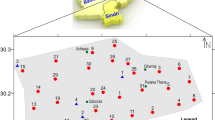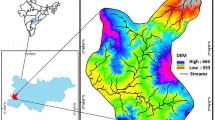Abstract
The dependence of human beings on groundwater and ever-increasing demands of growing population, agriculture and industries, has resulted in its over-exploitation. This has led to the decline of groundwater levels and its shortage especially in lean season. The study area, Reodar block of Sirohi district, Rajasthan, is an over-exploited block with the stage of groundwater extraction at 159% and has an average declining water level trend at the rate of 0.24 m/year. Artificial recharge was proposed in the study area through the construction of recharge shafts and injection wells, after delineating the weathered thickness in the submergence area of existing ponds and check dams of the study area by carrying out vertical electrical sounding (VES).
In all, VES were conducted at 178 sites and recharge structures were constructed at 76 out of 109 scientifically selected sites with suitable weathered thickness and attempt was made to establish their impact on water levels through pre-monsoon water level monitoring. The comparison of pre-monsoon water level observations spanning over four decades reveals its spatio-temporal decline in the study area. The construction of these recharge structures has resulted in significant increase in area from 38% to 68%, under 0 to 20 m below ground level water level range. This study demonstrates the importance of resistivity surveys in scientifically selecting the suitable sites for construction of recharge structures and significance of long-term water level monitoring in assessing the groundwater scenario and impact assessment, in poorly characterized hydrogeological areas.
Similar content being viewed by others
References
Abraham Markutty and Mohan S. (2019) Effectiveness of check dam and percolation pond with percolation wells for artificial groundwater recharge using groundwater models, Water Supply, v.19(7), pp.2107–2115. doi:https://doi.org/10.2166/ws.2019.09
Aher, K.R., Suryakant M. Patil and Mane, V.P. (2015) Recharge Trench cum Recharge Shaft New Concept for Groundwater Recharge for Sustainability of Source: A Case Study. Internat. Jour. Curr. Medi. Appl. Sci., v.6(1), pp.17–21.
Anbazhagan, Siddan and Ramasamy, SM. (1997) Geophysical resistivity survey and potential site selection for artificial recharge in central Tamil Nadu, India. Engineering Geology and the Environment. Marinos, Koukis, Tsiambaos & Stoumaras (Eds.), Balkema, Rotterdam, pp.1169–1173.
Asanova. J., Devau N. and Pettenati M. (2016) Managed Aquifer Recharge: An Overview of Issues and Options. In: Jakeman A.J., Barreteau O., Hunt R.J., Rinaudo JD., Ross A. (eds) Integrated Groundwater Management. Springer, Cham. doi:https://doi.org/10.1007/978-3-319-23576-9_16
Boucher Marie, Favreau Guillaume, Descloitres Marc, Vouillamoz Jean-Michel, Massuel Sylvain, Nazoumou Yahaya, Cappelaere Bernard and Legchenko Anatoli (2009) Contribution of geophysical surveys to groundwater modelling of a porous aquifer in semiarid Niger: An overview, Comptes Rendus Geosci., v.341(10–11), pp.800–809. https://doi.org/10.1016/j.crte.2009.07.008.
CGWB (2013) Ground Water Information Booklet, Sirohi District.
CGWB (2017) Dynamic Ground Water Resources of Rajasthan, as on March 2017.
Dandekar, A.T., Singh, D.K., Sarangi, A and Singh, A.K. (2018) Modelling vadose zone processes for assessing groundwater recharge in semi-arid region. Curr. Sci., v.114(3), pp.608–614
Department of Mines and Geology, Sirohi Rajasthan, http://environmentclearance.nic.in/writereaddata/FormB/EC/Additional_Report/10072019AWA9ZVOJaddatt.pdf
District Survey Report (Minor Mineral Mining), Sirohi (Under Ministry of Environment, Forest & Climate Change, New Delhi, Notification Date 25-07-2018).
District Census Handbook Sirohi, Census of India 2011, Series-09 Part XII A. Directorate of Census perations, Rajasthan.
https://www.rajras.in/index.php/climatic-regions-of-rajasthan/ Climatic Regions of Rajasthan.
IWMP Sirohi — II, 2017, Panchyat Samiti Reodar.
Kavaran Gita (2006) The value of a Raindrop: Traditional RWH Systems in the Arid and Semi-Arid Regions of Rajasthan”, Final Report UNESCO, G-WADI Meeting on Water Harvesting ALEPPO, Syria 20–22nd November 2006.
Kumar Rajesh, Punia M.P., Singh, K.K., Singh Ranjeet, Singh Pragati and Lipi Kumari (2010) Sustainable Development and Management of Water Resources of Rajasthan. Internat. Res. Jour., v.1(1), pp.40–49
Kunetz, G., (1966) Principles of Direct Current Resistivity Prospecting. Gebruder Borntraeger Berlin Nikolassee. Geoexploration Monographs Series 1, no.1, New York.
Karanth, K.R. (2003) Groundwater Assessment, Development and Management, Tata McGraw-Hill Publishing Company Ltd., New Delhi, India.
Mac Donold, A. M. and J. A. Davies, 2000. Brief Review of Groundwater for Rural Water Supply in Sub- Saharan Africa. British Geological Survey Technical Report WC/00/33.
Muchingami Innocent, Hlatywayo Dumisani, Nel Jaco and Chuma, Constant. (2012) Electrical resistivity survey for groundwater investigations and shallow subsurface evaluation of the basaltic-greenstone formation of the urban Bulawayo aquifer. Phys. Chem. Earth, v.50–52. pp.44–52. doi:https://doi.org/10.1016/j.pce.2012.08.014.
Orenella E. and Mooney H.M. (1966) Master Tables and Curves for Vertical Electrical Sounding over Layered Structures. Interciencia, Madrid, 34p.
Pujari, Vedavati, R. and Diwan, V.V. (2012) Proceeding of International Conference SWRDM-2012 Artificial Groundwater Recharging in India, http://www.unishivaji.ac.in/uploads/journal/Journal_42/37.pdf
Parasnis, D.S. (1997) Principles of Applied Geophysics, 5th Edition, Chapman and Hall.
Ramasamy, S.M., Kumanan, C., Mahalingam, S. and Nagappan, N. (2007) GIS based visualization of groundwater levels and its significance. Jour. Geomatics, v. 1, pp.17–22.
Shaktivadivel Ramaswamy (2007) The Groundwater Recharge Movement in India, Book The Agricultural Groundwater Revolution: Opportunities and Threats to Development pp.195–210.
Sharma, K.D. and Chatterji, P.C. (1982) Sedimentation in Nadis in the Indian Arid Zone, Hydrolog. Sci. Jour., v.27(3), pp.345–352, doi: https://doi.org/10.1080/02626668209491114
Singh, K.P., Dookia, P.P. and Devi, Sunita (2019) Report on Resistivity Surveys for Deciphering the Weathered Thickness in Ponds of Reodar Block, District: Sirohi, Rajasthan. CGWB, WR, Jaipur report.
Singh, K.P., Dookia, P.P. and Devi, Sunita (2019) Report on Resistivity Surveys for Deciphering the Weathered Thickness in Ponds/Nadis for Recharge Plan of Reodar Block, District: Sirohi, Rajasthan. CGWB, WR, Jaipur report.
Singh, Kanwar P. and Kanwar, Priya (2014) Delineation of Subsurface Fractures as Groundwater Potential Zones by Geoelectrical Resistivity Techniques at Khumbathang, District: Kargil, Jammu & Kashmir State, India. International Conference on Integrated Water, Wastewater & Isotope Hydrology, Banglore University, Bengaluru, v.I, pp.138–144.
Todd, D.K. (1980) Groundwater Hydrology, 2nd Edition, John Wile & Sons, Berkeley.
W. Martin-Rosales Æ J. Gisbert Æ A. Pulido-Bosch Æ A. Vallejos Æ A. Fernández-Cortés (2007) Estimating groundwater recharge induced by engineering systems in a semi-arid area (south-eastern Spain), Environ Geol., v.52, pp.985–995. doi: https://doi.org/10.1007/s00254-006-0541-5
Author information
Authors and Affiliations
Corresponding authors
Rights and permissions
About this article
Cite this article
Kanwar, P., Singh, K.P. Identification of Suitable Recharge Sites by Integrated Hydro-geophysical Approach for Augmenting Groundwater in Reodar Block, District Sirohi, Rajasthan. J Geol Soc India 98, 1447–1454 (2022). https://doi.org/10.1007/s12594-022-2192-x
Received:
Accepted:
Published:
Issue Date:
DOI: https://doi.org/10.1007/s12594-022-2192-x




